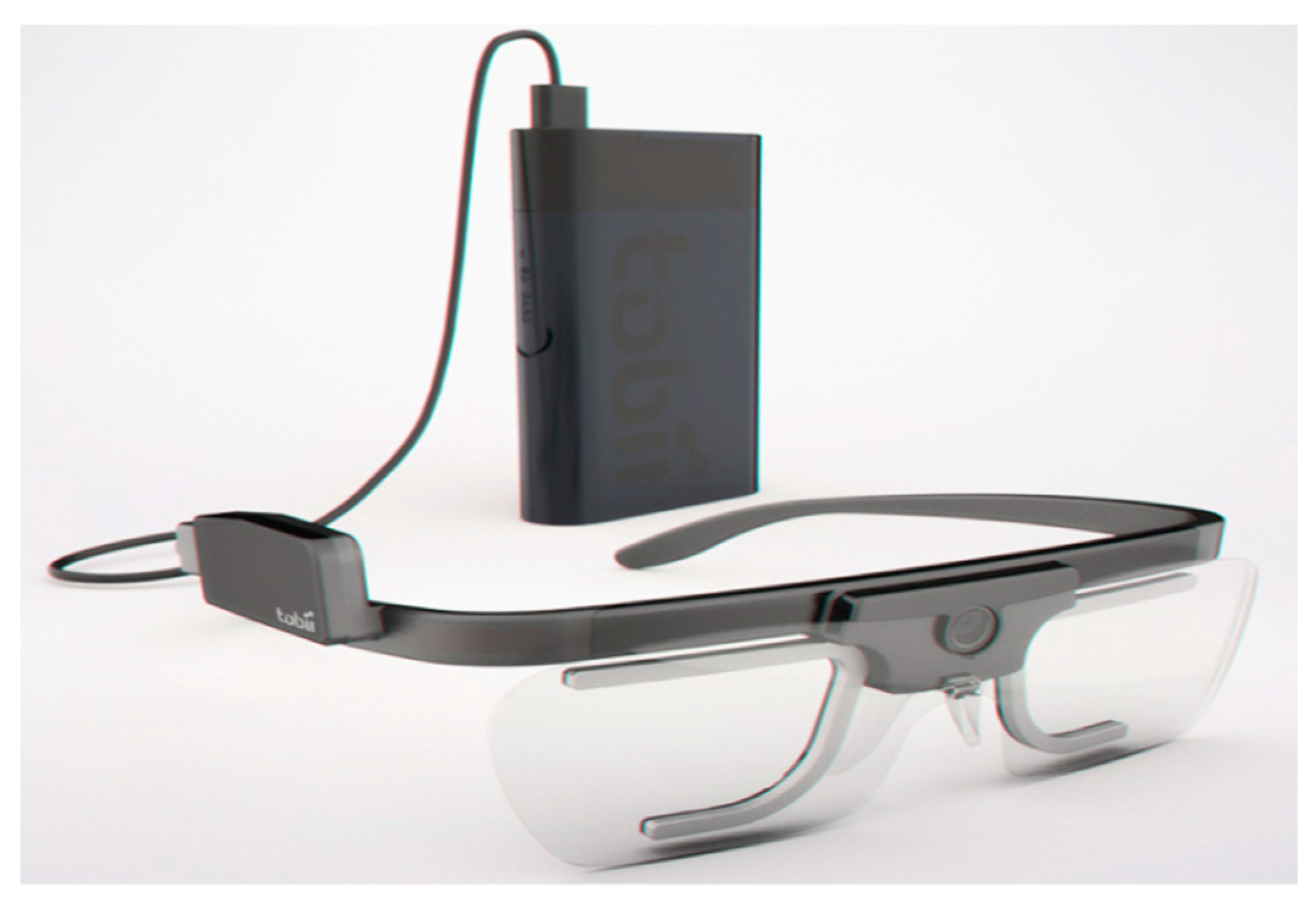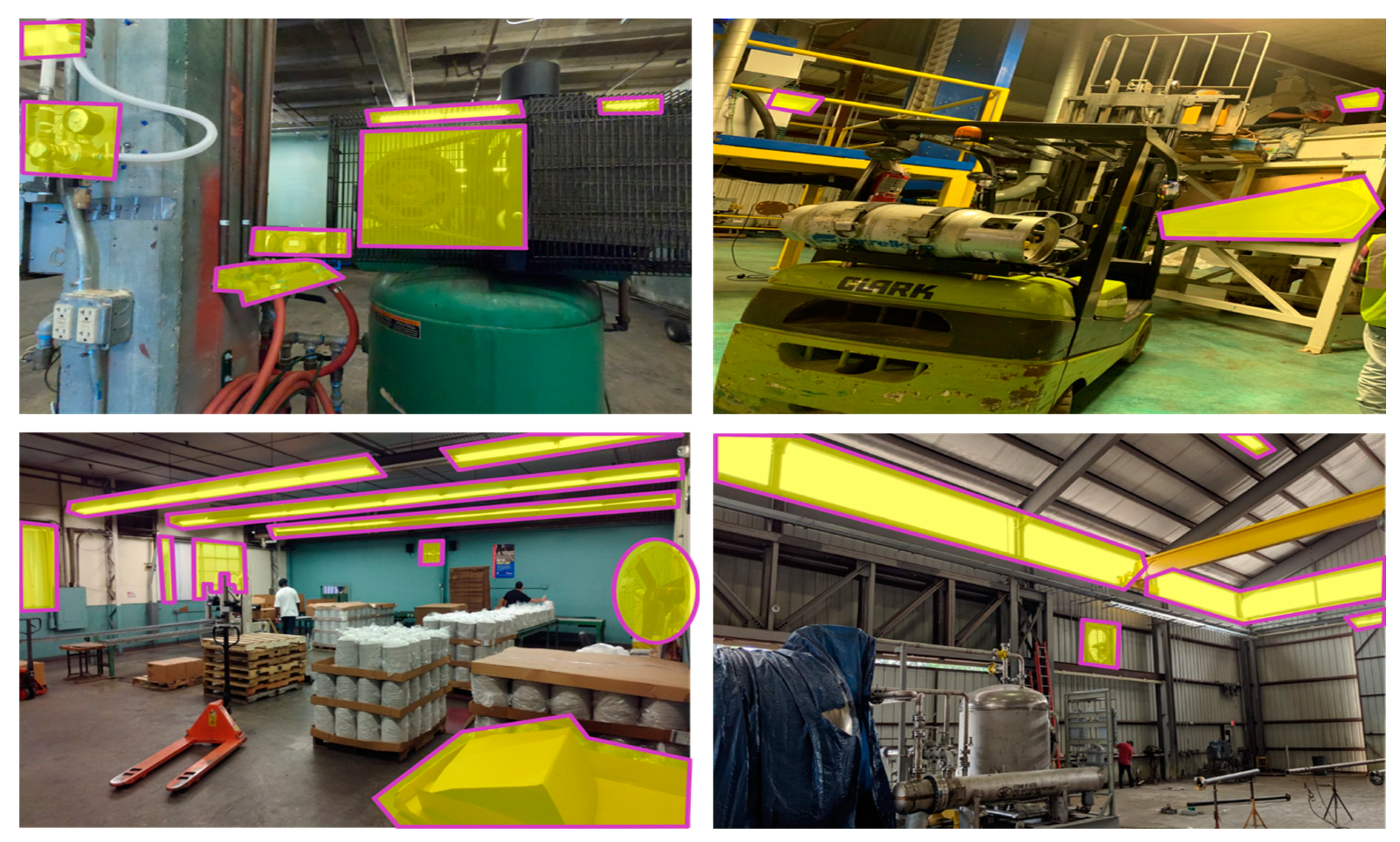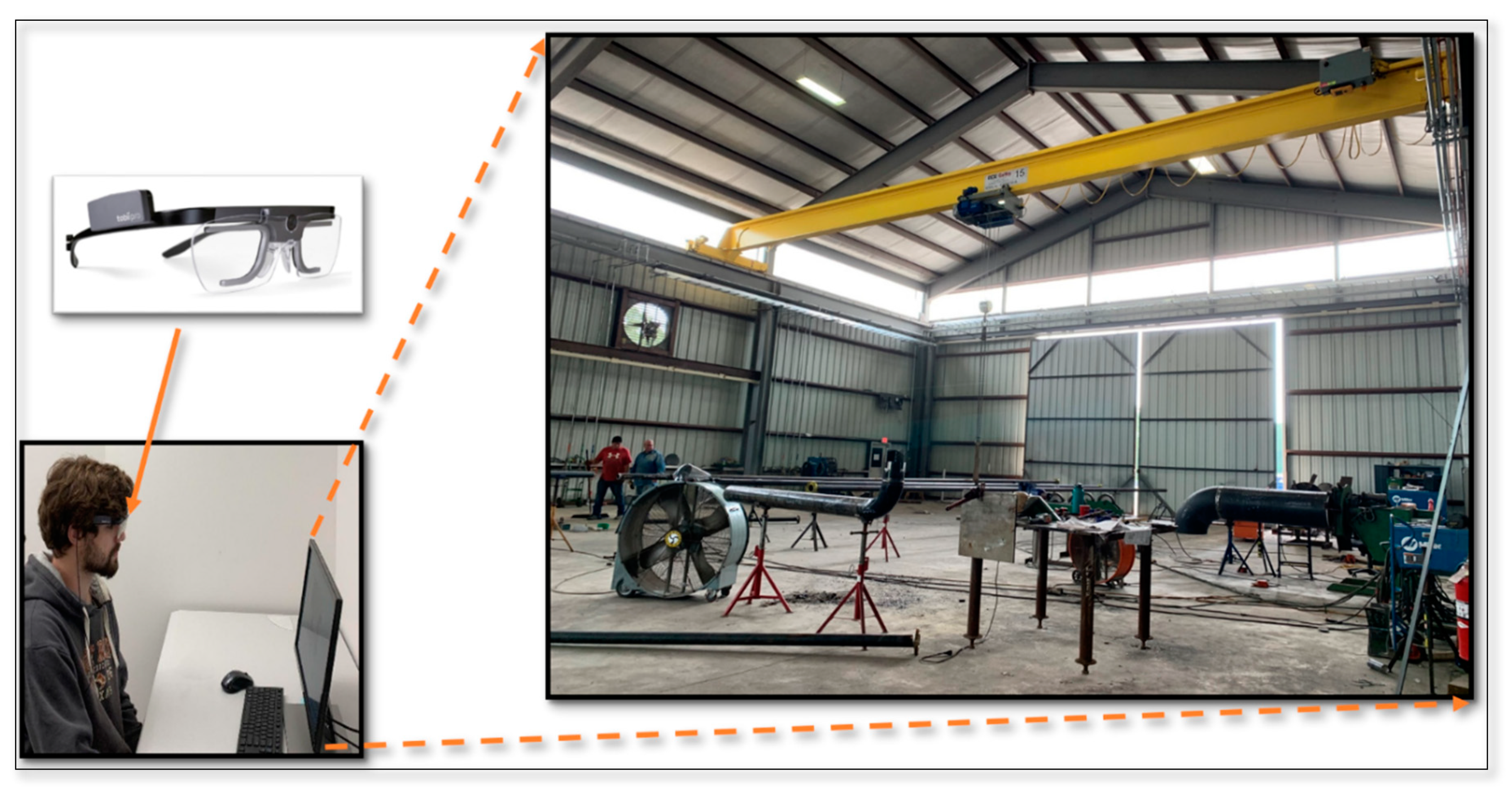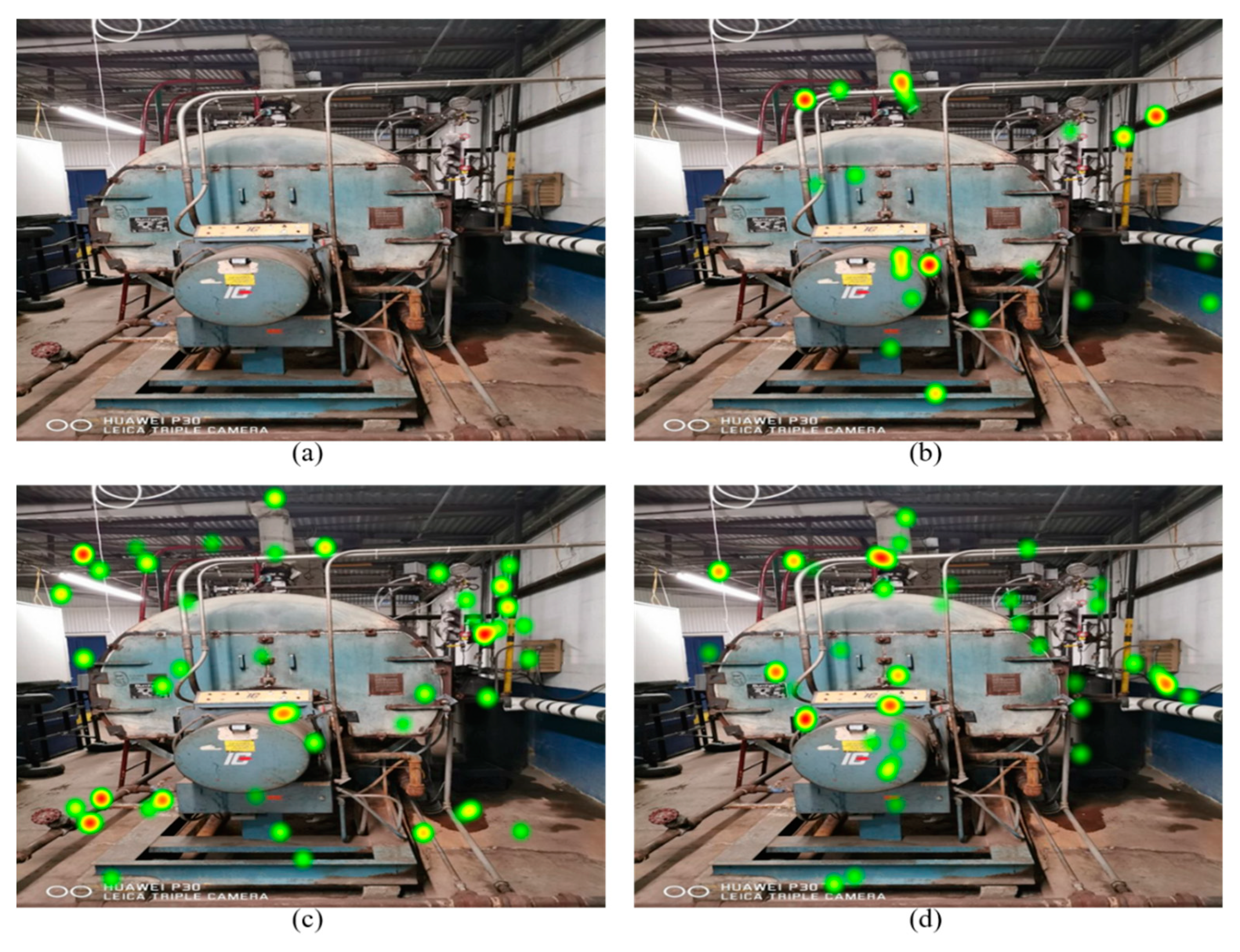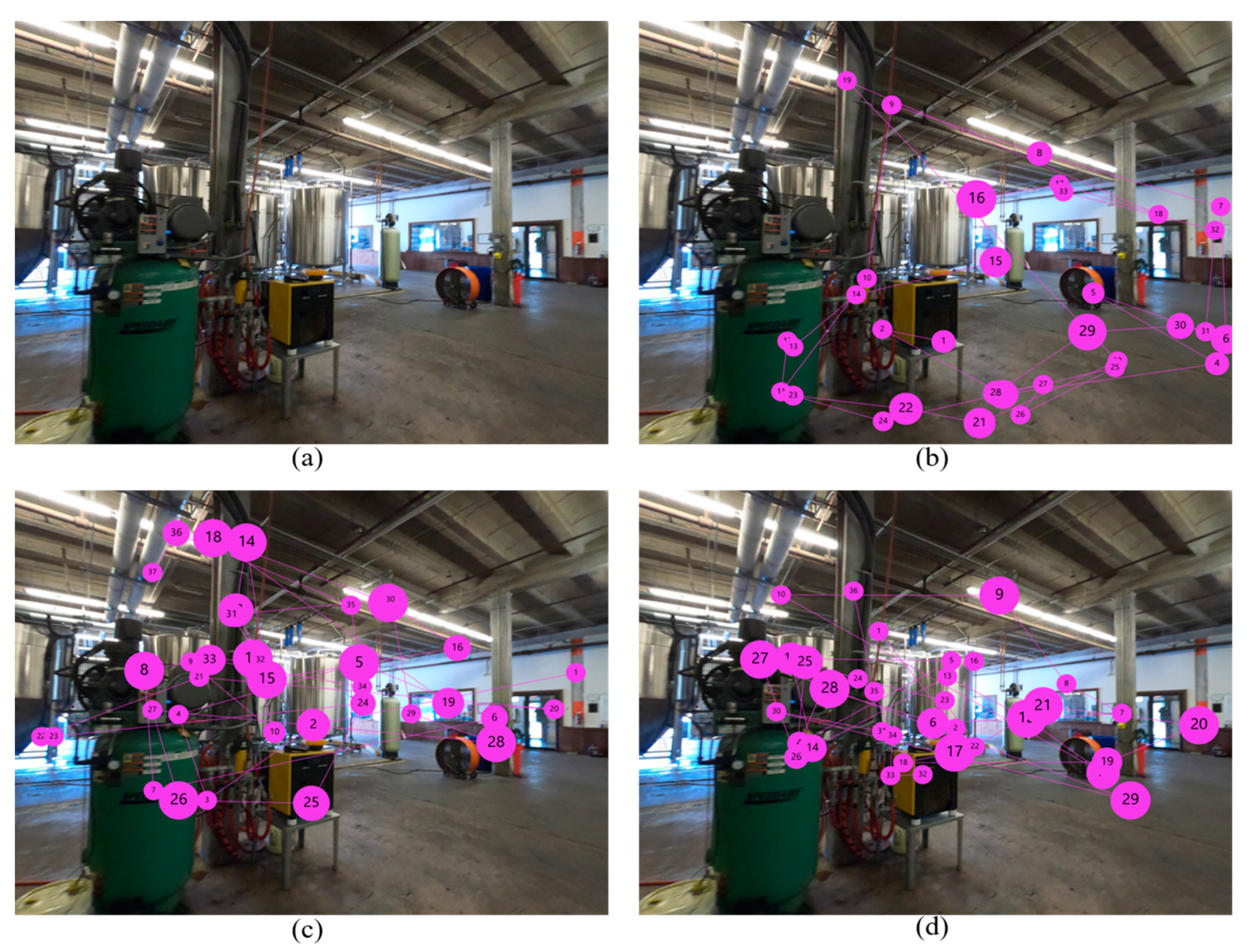2. Materials and Methods
In this study, a novel evaluation procedure for investigating the effectiveness of training methods about the performance of students in facility energy assessment was developed. Training content was collected from a combination of field energy assessment experience, management concerns, IAC training materials, and general industry knowledge from industrial energy assessment experts. The designed experiment was divided into four sections: (1) collecting data on subjects about their attentional allocation behavior to potential energy-saving opportunities before the training; (2) training subjects in the class environment; (3) testing the trainees’ knowledge level after the training using a traditional quiz; and (4) evaluating the subjects’ performance on identifying the energy-saving opportunities after the training session. Before starting the experiment, all the experimental procedures were approved by the Institutional Review Board (IRB) at Louisiana State University (IRB# 4293).
2.1. Participants
Sixteen college students (two females, fourteen males) from Louisiana State University participated in the experiment. They were at different levels of the school year (four graduates, five juniors, four seniors, and three sophomores). All the participants were young, with a minimum age of 20 years old and a maximum age of 31 years old (25% equal or more than 25 years old, 75% less than 25 years old). Of the participants, 31% had (one year or more) experience in energy assessment activities, and 69% of them did not have any work experience in energy assessment and had not received any training in energy assessment (in-class or in-field). Before starting the experiment, participants were required to fill out a questionnaire regarding their medical history (e.g., eye problems) as well as experience and training in energy assessment activities. For analyzing data, at first, data collected through questionnaires were evaluated and those data related to participants who suffered from eye problems were removed. In the next step, to categorize participants, two factors were used: experience, and training. Thus, students who had not received any training (in-class or on-field) and did not have any energy assessment experience were in one group, A1, students who received the in-class training were in group A2 and, experienced participants were in the group A3.
Based on the participants’ medical history data, one of the participants did not meet the requirement for experimenting. Therefore, data related to that student were removed, and the analysis of data was performed based on data of fifteen participants who did not have any medical issues (ex. eye movement abnormalities, eye surgery). Eye problems may cause issues in the accuracy of the collected data. Finally, 75% of subjects who did not have any work experience in energy assessment or receive any prior training in this area received in-class training in the experiment.
2.2. Eye-Tracking Device
Tobii Pro Glasses 2 (manufactured by Tobii AB Company, Danderyd Municipality, Sweden) were used in this study to capture the visual behavior of participants. This eye-tracker has a high spatial resolution and a sampling rate of 100 Hz and contains four cameras (two for each eye) that can record the movement of each eye. The eye-tracker glasses were calibrated on each subject during each section of the experiment. As shown in
Figure 1, the eye-tracker has an excellent ability to support automatic slippage compensation. This means that slippage of head units, which is unavoidable during a study, does not have an impact on the quality of data, because the eye-tracker remains calibrated using a gyroscope and accelerometer sensors.
2.3. Scenario Images and Areas of Interest
To prepare images for the experiment, we collected around 2000 images of energy-saving opportunities from several real facilities during the field industrial energy assessments. Then, certified practitioners screened these images and selected 40 images with 96 areas of interest (AOIs) as potential energy-saving opportunities. AOIs could be located in one of the following categories: production (furnace, oven, boiler, pump, chiller, cooling tower, motor system, air compressor), building and HVAC (building envelope insulation, lighting, HVAC system, skylight, occupancy sensor, thermostat), and recycling and waste management (recycling baler, recyclable material, anaerobic digestion of wastewater sludge). As shown in
Figure 2, AOIs within each image have been manually predefined by the industrial energy assessment experts to capture the attention of each AOI, in
Figure 2, each highlighted area is an individual AOI for data collection.
The size of AOIs has a significant impact on the accuracy of the analysis. Holmqvist et al. [
28] analyzed the size of AOIs, and they advised to keep the maximum size for AOIs to include all fixations which belong to an object. Orquin et al. [
29] discussed the impact of AOI size on the measurement of object attention and conclusion about cognitive processes. They reanalyzed four published studies to find the optimal size of AOIs. They suggested that, in studies with overlapped fixation distribution (smaller distance between objects), smaller AOI sizes would produce the best results. In comparison, when there is a more considerable distance between objects, it is recommended to use larger AOIs. They explored an AOI margin of 0.5° of visual angle for the best-fitted model of overlapped fixations. At the same time, the primary studies on AOI sizes prescribed a visual angle margin of 1–1.5° for all experiments [
28]. It was suggested in experiments with the freedom to design stimuli, that the maximum distance between objects would reduce the overlapping of fixation distribution as well as error in the analysis [
29].
2.4. Data Collection
Before the experiment started, students were asked to answer questions about their experience, certificate, and training in energy assessment activities. Moreover, because this study was designed based on eye-movement tracking, it should be confirmed that participants did not have eye problems. Therefore, participants were required to answer some questions related to their medical history before starting the test. In the first step of the experiment, students had to look at each image shown on the monitor of a desktop computer for 15 s and look for potential energy-saving opportunities (
Figure 3). Participants were seated approximately 45 cm from the monitor. Simultaneously, a wearable eye-tracker was used to capture participants’ visual attentional behavior. After each image, students had to answer a question about the amount of energy-saving opportunities they identified in the image. In the second section of the experiment, students who did not have any training, experience, or certificate in energy assessment (group A1) attended a training program that was hosted by a certified energy efficiency practitioner. Training topics were categorized into three sections: recycling and waste management, production, and buildings and HVAC systems. The first training part included energy-saving opportunities related to wastewater and recyclable material. The content of the second part was about process heating systems such as boilers, process cooling systems such as chillers, and motor systems such as air compressors. In the last section of training, material related to energy-saving opportunities for lighting, HVAC systems, and building insulation was presented. During the training program, students were taught to look for what type of information related to each energy-saving opportunity. They were trained about the essential information needed to be collected during an energy assessment session. Multiple images from the real facility were shown to students during the training program to familiarize them with energy-saving opportunities in the facilities.
In the third step, the enhancement of participants’ knowledge about energy assessment topics was investigated. Students were required to take a quiz about training content. The goal of this quiz was to understand whether students had learned what has been taught during the training. The results of this phase helped us to prune participants for the final stage of the experiment. It means that participants who could not achieve the acceptable grade (80%) in this test were not qualified for the final step of the experiment. In the last phase of the study, the energy assessment performance of participants after being trained was evaluated. Therefore, trainees were requested to identify potential energy-saving opportunities from images shown on the monitor while the eye-tracker recorded their visual attentional behavior. Participants looked at each picture for 15 s; then, they answered a question about the amount of penitential energy-saving opportunities they identified in the image. It should be noted that the same images were used for the first and last sections of the experiment.
2.5. Data Analysis
In this study, data collection was performed based on the requirements to test two hypotheses (
Table 2). Two types of variables were considered: performance in energy assessment (energy assessment knowledge, i.e., training, experience, and a certificate in energy assessment) as the independent variable and eye-tracking metric (fixation) as the dependent variable. Data related to the independent variable were gathered through a questionnaire before starting the experiment. Participants responded to questions such as whether they had work experience related to energy assessment, or whether they had any energy assessment certificate, or whether they had received any energy assessment training (in-class or in-field). Data related to the dependent variable were collected using the eye tracker. In this study, one of the common fixation-related metrics-the fixation duration, was analyzed. Data provided by the eye tracker were screened based on the students’ responses to questions related to the amount of energy-saving opportunities identified from the image. These questions were displayed on the screen after showing each image. For example, if there were two potential energy-saving opportunities in the image but the student only found one, data related to one opportunity were used for analysis.
In the experiment, participants were separated into groups based on the collected data from the questionnaire to test the hypotheses. For hypothesis 1, the performance of group A1 and group A2 were compared and, for hypothesis 2, group A2 and group A3 were compared.
In this study, the performance of energy assessment was evaluated based on the participant’s visual attentional behavior during the experiment. We conducted the data analysis in the data analytics tool (Tobii Pro Lab) provided with the eye tracker, which automatically mapped the collected eye movement data to the corresponding AOIs. Then, within each AOI, the eye-movement data were further analyzed to obtain the fixation duration data of each participant based on the data provided by the eye tracker and participants’ responses to questions displayed after each image. The eye tracker recorded the locational patterns of eye movement, which were finally analyzed to generate a graphical representation of the visual behavior of participants, such as gaze plots and heat maps.
The main goal of this study was to evaluate the effectiveness of the designed training program in enhancing students’ performance during an energy assessment. Therefore, the performance of participants before and after the training session was compared. A Student’s
t-test was adopted to compare the average of two groups. Several requirements, such as independent subjects, normality, and homogeneity of variances, must be satisfied for using a
t-test [
30]. Independency of subjects means that no item or subject can belong to two groups simultaneously. Normality means measured data in the experiment should be approximately normally distributed. In this study, a Shapiro–Wilk’s W test was applied to test the normality of datasets, because the number of samples was small. Homogeneity of variances means that variances are equal across the groups which are compared. Regarding the homogeneity of variances, Levene’s test, which considers the null hypothesis that, “the variance is equal across the groups which are compared” [
31] was used. Homogeneity of variances can be ignored if the number of subjects for two groups that are compared is the same.
3. Results and Discussions
The performance of participants in the energy assessment was divided into three categories (recycling and waste management, production, buildings and HVAC) based on the in-class training material. Data related to the first hypothesis are shown in
Table 3, which tests the impact of in-class training on the performance of students in the energy assessment3.
Table 4 shows the result of the experiment for hypothesis two, which compared the visual attentional behavior of two groups of participants (experienced students (A3) vs. students who received in-class training (A2)) in recognizing energy-saving opportunities.
In this study, the participants were separated into three groups for comparison: pre-training group, post-training group, and experienced group. These groups have completely independent subjects. The first group were participants who did not have any experience or receive any training (in-class or on-field) related to industrial energy assessment; the subjects of group A1 were independent of the second group subjects who received the designed in-class training. On the other hand, subjects of the third group were experts with in-field experience. Therefore, the subjects of the experiment were different and unrelated and satisfied the requirement (independent subjects) for the t-test. Next, we further analyzed the data from the perspectives of independent subjects, normality, and homogeneity of variances to ensure the data collected meet the requirement of the Student’s t-test.
Regarding the normality, because the number of samples was not large, the Shapiro–Wilk’s W test (at the significance level of 0.05) was used to test the normal distribution of each group separately.
Table 5 shows the results of Shapiro–Wilk’s W test. Based on the provided result,
p > 0.05 for each group individually, the null hypothesis (the data is normally distributed) was retained, and normality could be assumed for the dataset.
Table 6 indicates the results of Levene’s test (at the significance level of 0.05). It should be noted that because of the equal sample sizes, Levene’s test was not performed between group A1 and group A2. Based on the results provided by Levene’s test, the
p-value is more than 0.05 in all experiments. Therefore, the null hypothesis was retained, and equality of variances across the groups was assumed.
As analysis is shown above, three requirements (normality, independent subjects, and homogeneity of variances) for using a parametric test were satisfied. Therefore, we applied the
t-test (at a significant level of 0.05) to compare the energy assessment performance of subjects who participated in the experiment (
Table 7). In the first analysis, the visual attentional behavior of subjects, before and after training, was discussed based on three categories: production, building and HVAC, and recycling and waste management. A total of 75% of participants in the experiment received in-class training. These subjects did not have any work experience in energy assessment. They also had not received any training (in-class or in-field) related to energy assessment activities before the current experiment. Results showed that the attentional behavior of students to energy-saving areas related to production increased after the training program (
t = 2.465.
p = 0.011 < 0.05). Therefore, the training program had a positive effect on enhancing the subject’s knowledge about energy assessment related to production areas. Regarding building and HVAC areas, performance of students did not change significantly after training (
t = 0.817,
p = 0.211 > 0.05). Therefore, the null hypothesis could not be rejected in this test, and it was assumed that the participant’s attentional behavior to energy-saving opportunities related to building and HVAC was similar before and after training. It can be concluded that training contents need to be improved in the area of building and HVAC. Regarding the recycling and waste management area,
t-test results indicated that the knowledge of subjects after training increased (
t = 1.721,
p = 0.05). Therefore, contrary to the null hypothesis, the training program had a significant positive impact on trainees’ ability to recognize energy-saving opportunities related to the area of recycling and waste management.
The second analysis compared the performance of students who received the in-class training (group A2) with the performance of experienced subjects (group A3) in energy assessment. Of these, 25% of participants in this study had one year or more experience in energy assessment activities, and 75% of subjects received the in-class training; those who had not any experience related to energy assessment and had not received any training (in-class or on-field) in this area. The results showed that for the production area, the null hypothesis could not be rejected (t = 0.585, p = 0.568 > 0.05) and equality of performance of students who received the training program (group A2) with the performance of experienced participants (group A3) in energy assessment was retained at a significance level of 0.05. Therefore, it showed that the training program was good enough to enhance the knowledge of participants to the level of experienced subjects’ knowledge in recognizing energy-saving opportunities in the production area. Regarding building and HVAC area, Group A2 and group A3 demonstrated the same performance (t = 0.127, p = 0.9 > 0.05). Therefore, the null hypothesis was retained at a significance level of 0.05 in this test. Considering the result of the first hypothesis, it could be concluded that neither training nor experience has a significant impact on participants’ visual attentional behavior in recognizing energy-saving opportunities in the area of building and HVAC. Regarding recycling and waste management, the results showed that the performance of students who received the training (group A2) was not the same as the performance of experienced subjects (group A3) (t = 2.275, p = 0.04). It means that the null hypothesis was rejected (at a significant level of 0.05) in favor of the alternative hypothesis (performance of the students who received the training (group A2) was not equal to the performance of students who were experienced (group A3)). Therefore, the research team decided to consider another alternative hypothesis to check whether the students who received the in-class training (group A2) showed better or worse performance compared with experienced subjects (group A3). Results indicated that, after the training, students demonstrated better performance in recognizing energy-saving opportunities in the area of recycling and waste management compared with experienced subjects (t = 2.25, p = 0.02). Therefore, the training program was effective in this area.
This study intended to use the results to identify whether there was a noticeable and measurable positive change in the performance of participants in energy assessment after receiving training. Therefore, the visual attentional behavior of participants was monitored during the experiment to investigate their progress in recognizing potential energy-saving opportunities. The first null hypothesis concerned comparing participants’ performance in energy assessment before and after receiving the in-class training. The results showed that participants’ knowledge in two areas (production, recycling, and waste management) increased significantly after receiving the training.
Regarding the building and HVAC area, a significant difference in the visual attentional behavior of participants was not observed. Considering the content of the training program in the building and HVAC area, it could be concluded that participants were familiar with the presented topics even before receiving the training program because, in this area, the covered material for training was about lighting, HVAC, doors, and windows. The results demonstrated that the training program was successful in enhancing subjects’ knowledge about recognizing energy-saving opportunities.
The second null hypothesis was about comparing the energy assessment performance of participants who received the in-class training with the performance of participants’ who were experts with in-field assessment experience. Experimental results indicated that participants who received the in-class training had the same performance or even better than experienced people. Regarding production areas, training content was successful in enhancing the participants’ knowledge to the knowledge level of experienced people. It means that, after the training, participants who received the in-class training showed the same performance in energy assessment comparing with experienced subjects. Regarding the area of building and HVAC, the performance of experienced participants and participants who received the in-class training was the same in recognizing energy-saving opportunities. In the field of waste management and recycling, the application of training content was fantastic; the result showed that subjects who received the in-class training had better performance in recognizing energy-saving opportunities compared with people who were experienced. Therefore, based on data analysis, the energy assessment training program was effective in enhancing students’ knowledge.
By comparing the post-training performance of students with the performance of experienced and certified energy practitioners, it can be determined whether a trainee is qualified to become a certified energy practitioner. All the experienced people who participated in this study were certified energy practitioners, therefore comparing the performance of experienced participants (group A3) with subjects who received the in-class training (group A2) was similar to comparing the performance of energy certified practitioners and participants who received the in-class training (group A2). Based on the data analysis, subjects who received the in-class training had enough knowledge to become energy-certified practitioners because they demonstrated the same performance or even better in recognizing energy-saving opportunities compared with people who possessed energy certifications.
The experienced participants of the current study had not received any in-class training before performing the experiment, and they gained experience during attending energy assessment sessions on the field. Therefore, comparing the performance of students who received the in-class training (group A2) with the performance of experienced participants (group A3) also provided useful information about enhancing knowledge in energy assessment through two different methods (in-class and in-field). The students who received the in-class training (group A2) demonstrated the same or better performance in recognizing energy-saving opportunities compared with participants who obtained energy assessment knowledge through attending the real facilities. Therefore, it can be concluded that the in-class training was as positive as the training in the real environment of a facility.
The depicted attentional distributions (
Figure 4) show that subjects pay more attention to energy-saving opportunities after receiving the in-class training. Moreover, heat map comparisons indicated that participants who received the in-class training demonstrated similar attentive behavior toward areas of interest compared with experienced participants.
Figure 5 shows the search patterns of participants using the gaze plot. A gaze plot is a useful tool for discovering the participants’ eye path and cognitive process. The scan paths also validate the results obtained through statistical analysis, which demonstrates more attention to energy-saving opportunities after receiving the in-class training by participants. Additionally, the search strategy of participants who received in-class training was similar to experienced participants.
